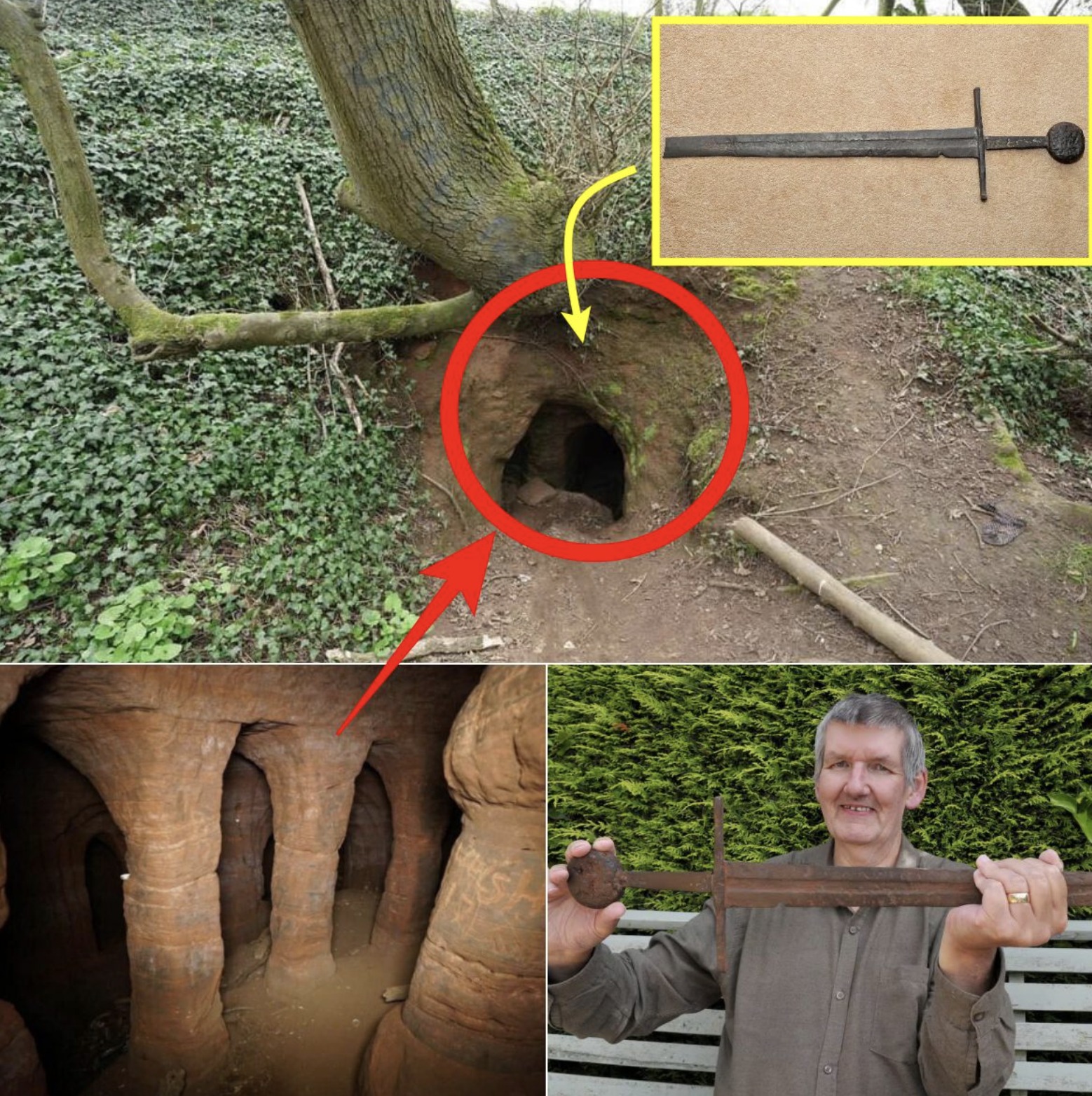Beneath the twisted roots of an ancient tree, deep in the heart of a secluded English estate, archaeologists have uncovered a hidden cave that could rewrite part of history. This extraordinary find, believed to be linked to the enigmatic Knights Templar, has sent shockwaves through the archaeological and historical communities. Inside the cave, researchers discovered a remarkably well-preserved 700-year-old sword, adorned with faint inscriptions and bearing the iconic cross pattée—an unmistakable symbol of the Templar order. The discovery has rekindled fascination with the Templars and their mysterious activities, raising new questions about their survival after their dramatic dissolution in the early 14th century.
The Knights Templar: Guardians of Secrets
The Knights Templar were founded in 1119, during the early days of the Crusades, by a group of knights dedicated to protecting Christian pilgrims traveling to the Holy Land. Over time, the order grew into a powerful and wealthy military and financial institution, with influence spanning across Europe, the Middle East, and even the far reaches of Asia. The Templars were renowned not only for their prowess in battle but also for their advanced banking systems and vast network of fortresses and estates. Their wealth and influence, however, eventually became their downfall.
In the early 14th century, King Philip IV of France, heavily in debt to the Templars, orchestrated a campaign to seize their assets and disband the order. In 1312, under immense pressure from Philip, Pope Clement V officially dissolved the Knights Templar. The knights were accused of heresy, blasphemy, and other charges, many of which are widely believed to have been fabricated as part of a larger political maneuver. The Templars were rounded up, arrested, and subjected to brutal torture in an attempt to extract confessions, but many of their secrets and knowledge were lost in the aftermath of the purge.
Despite the official disbandment, rumors of the Templars’ continued existence persisted for centuries. Various legends and conspiracy theories have suggested that the Templars went underground, taking their wealth, knowledge, and perhaps even their sacred relics with them. The recent discovery of the sword in the hidden cave has reignited speculation about the order’s survival and whether they did, indeed, retreat to secret hideouts in the years following their dissolution.
A Mysterious Cave: Sanctuary or Refuge?
The cave, located on a private estate in England, was carefully concealed beneath the roots of an ancient tree, indicating it had remained hidden for centuries. Archaeologists believe that the cave may have served as a sanctuary for Templar knights who were fleeing persecution after the dissolution of the order. The secluded location, deep within a forest and far from prying eyes, suggests that it was used as a refuge, providing safety and secrecy to those who sought to evade the reach of the church and the state.
While the exact purpose of the cave remains unclear, its discovery has fueled theories that the Knights Templar may have established secret strongholds in remote locations, where they could continue their operations in secret. It is well-documented that the Templars operated across Europe, and some records suggest that certain members of the order may have escaped to regions such as Scotland, Spain, and Portugal, where they could maintain their power and influence in the shadows.
The presence of the sword inside the cave is particularly significant. Unlike many medieval weapons, which have long since rusted or deteriorated, this sword was found in an unusually well-preserved state. It appears to have been carefully crafted, possibly by skilled Templar blacksmiths, and is adorned with faint engravings that may provide clues about its origin and the time period in which it was made. The cross pattée, a symbol synonymous with the Templar knights, is clearly visible on the sword’s hilt, offering a tangible link to the order’s medieval legacy.
The sword’s age, combined with its impeccable condition, strongly suggests that it may have been intentionally hidden or buried in the cave, perhaps to preserve it for future generations or to safeguard it from those who would seek to destroy Templar artifacts. Its discovery may provide new insight into the Templars’ rituals, weapons, and methods of hiding valuable objects during a time of intense persecution.
Scientific Analysis: Unraveling the Mysteries
As archaeologists and historians work to unravel the mysteries surrounding the cave and its contents, ongoing scientific analysis will be crucial in determining the true origins of the sword and its connection to the Knights Templar. One of the first steps in this process will be radiocarbon dating, which will help to establish an accurate timeline for the sword’s creation and burial. This analysis will also help to determine whether the sword was indeed used by the Templars during their active years or if it was a later addition to the cave.
Material studies will also play a critical role in determining the sword’s authenticity. By examining the metals used in its construction, researchers can gain insight into the technological advancements of the Templars and how their weapons were crafted. In addition, microscopic analysis of the sword’s inscriptions may reveal hidden details that could shed light on its significance within the order’s hierarchy and its possible use in Templar rituals.
The research team also hopes to conduct a thorough survey of the cave itself, searching for additional artifacts or signs of Templar activity. If other objects—such as manuscripts, religious relics, or documents—are found, they could provide further proof of the Templars’ secretive operations and the role this cave played in their survival.
The Templar Legacy: Myths, Legends, and New Discoveries
The discovery of the sword in the cave has sparked renewed interest in the Knights Templar and their mysterious legacy. For centuries, the order has been the subject of fascination, with countless myths and legends surrounding their activities. Some have speculated that the Templars discovered lost treasures or secret knowledge during the Crusades, while others believe they may have been involved in the creation of powerful secret societies, such as the Freemasons.
Despite the many theories and speculations, much of the history of the Knights Templar remains shrouded in mystery. Official records from the time of their dissolution are scarce, and many of the Templars’ secrets were lost when the order was disbanded. However, discoveries like the one made in the hidden cave continue to offer tantalizing glimpses into the past, fueling interest in the Templars and their possible survival after 1312.
While some have drawn comparisons between this recent discovery and other sites associated with the Templars, such as the Caynton Caves in Shropshire, there is still no definitive evidence linking the caves to the order. The Caynton Caves, for example, were believed to have been constructed in the 19th century as a folly, rather than being authentic Templar hideouts. Nonetheless, the sword found in the cave offers new hope that, with continued research and scientific analysis, the true extent of the Templars’ legacy may finally be revealed.
Conclusion: A Hidden Chapter of History
As archaeologists continue to investigate the hidden cave and its remarkable contents, the possibility of uncovering new insights into the Knights Templar’s activities grows ever more tantalizing. While definitive proof linking the Templars to this particular site remains elusive, the discovery of the 700-year-old sword offers a compelling piece of the puzzle, one that could reshape our understanding of the medieval order and its role in European history.
The Knights Templar were not only military leaders but also financial innovators, architects, and explorers. Their influence extended far beyond the Crusades, leaving an indelible mark on medieval Europe. With each new discovery, such as the one found beneath the ancient tree, we get closer to unraveling the mysteries of their secretive existence. As research continues, it is possible that this newfound artifact will illuminate a hidden chapter of history—one that has long been buried beneath the roots of time.

